Indonesia Satellite Communications Market Size
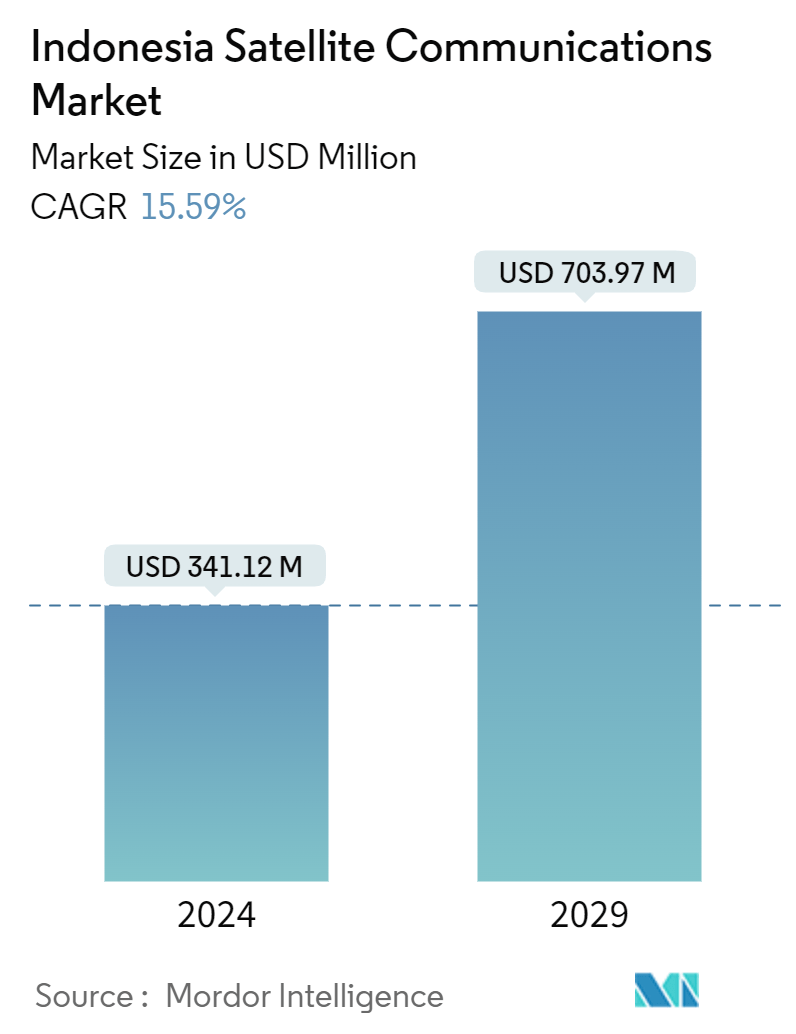
| Study Period | 2019 - 2029 |
| Base Year For Estimation | 2023 |
| Market Size (2024) | USD 341.12 Million |
| Market Size (2029) | USD 703.97 Million |
| CAGR (2024 - 2029) | 15.59 % |
| Market Concentration | Low |
Major Players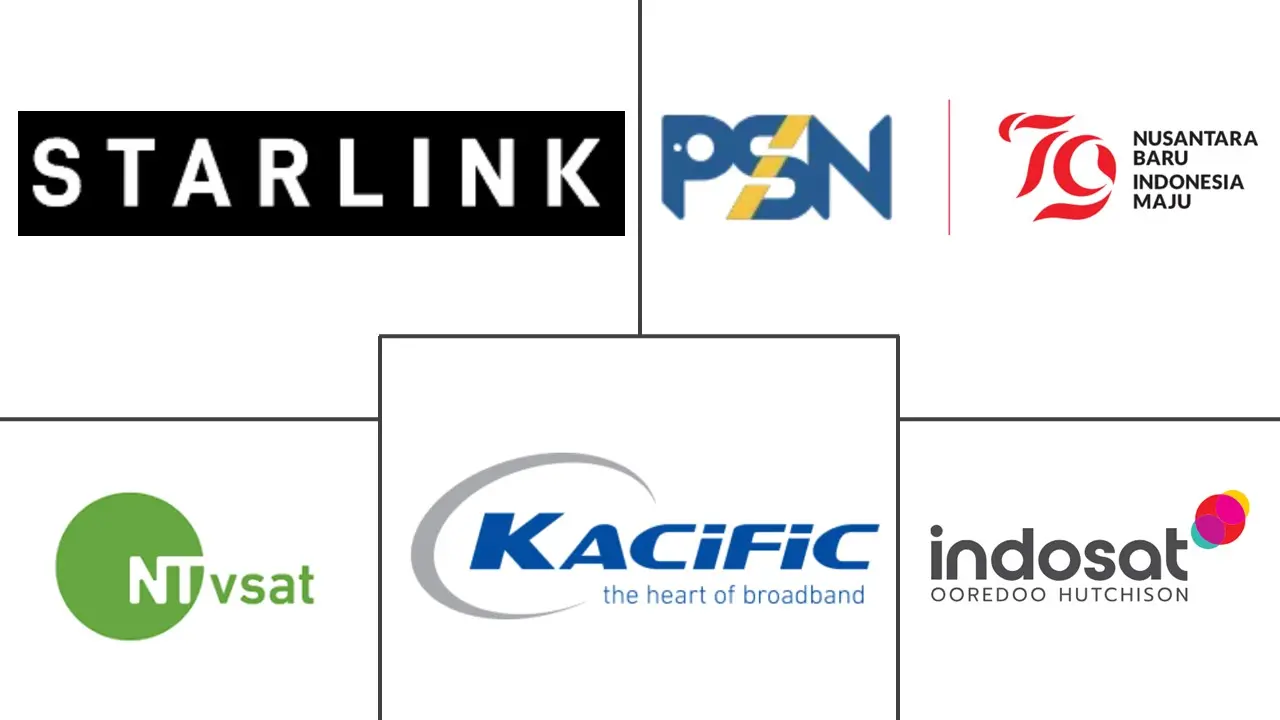
*Disclaimer: Major Players sorted in no particular order |
Indonesia Satellite Communications Market Analysis
The Indonesia Satellite Communications Market size is estimated at USD 341.12 million in 2024, and is expected to reach USD 703.97 million by 2029, growing at a CAGR of 15.59% during the forecast period (2024-2029).
Satellite communication is used for various applications across industries, such as media broadcasting, an extension of broadband coverage, 5G communications systems, integration and convergence of diverse wired and wireless technologies, earth observation, defense and security, and surveillance applications.
- To fulfil the operations, the solutions leveraging terrestrial mobile communication infrastructures, typically like long-term evolution (LTE), are relatively slow, expensive, and not easily scalable. Satellite communication is an efficient alternative because of its superior reliability, cost-effectiveness, excellent accessibility, and scalability, thereby providing plenty of opportunities for the growth of the market being studied.
- As the Government of the Republic of Indonesia diligently pursues the ambitious goal of Indonesia Emas 2045 (Golden Indonesia 2045), the nation's satellite development is entering a critical phase. The SATRIA-1 Satellite has significantly progressed, ensuring seamless telecommunications access to even Indonesia's most remote regions (3T). This achievement has revolutionized connectivity, enhancing internet access and communication in distant areas. These advancements have benefited sectors such as education, health, and the economy, laying a strong foundation for further leveraging satellite technology to drive economic growth and improve societal welfare.
- The expansion of 5G satellite communication is significantly driving the market's growth. This development is pivotal in addressing the connectivity challenges in the archipelagic nation, where terrestrial infrastructure often falls short. With 5G technology, satellite communication offers high-speed internet access even in remote and underserved areas, facilitating better integration into the digital economy and enhancing the quality of life for many Indonesians.
- Moreover, the Indonesian government has taken a proactive stance on digital inclusion and connectivity. Recognizing the strategic importance of satellite communications, the government has launched initiatives like the Palapa Ring project. This project aims to extend high-speed internet access to remote and underserved areas, often utilizing satellite technology to complement terrestrial networks. Such governmental initiatives significantly boost the demand for satellite communication services.
- The satellite industry is rapidly expanding, leading to high demand for STEM skills and difficulties for companies in recruitment. Efforts to tackle this issue are impeded by a lack of information, limited chances to enhance crucial abilities, and a deficiency of effective methods in hiring, education, and diversity.
Indonesia Satellite Communications Market Trends
Expansion of 5G Satellite Communication is Driving the Market
- The expansion of 5G satellite communication is significantly driving the growth of the market studied. This development is pivotal in addressing the connectivity challenges in the archipelagic nation, where terrestrial infrastructure often falls short. With 5G technology, satellite communication offers high-speed internet access even in remote and underserved areas, facilitating better integration into the digital economy and enhancing the quality of life for many Indonesians.
- Increased investments and strategic partnerships in Indonesia's telecom sector are driving the growth of 5G infrastructure. For instance, at the end of the 2023 fiscal year, PT Telkom Indonesia Group reported a total of approximately 43,047 telecommunications towers. Industry leaders are collaborating to deploy advanced satellite technologies, which are essential for meeting 5G's high bandwidth and low latency requirements. These investments are not only enhancing consumer connectivity but also strengthening sectors such as transportation, logistics, and aviation, thereby expanding the market's reach and impact.
- Furthermore, the Indonesian government's initiatives, such as launching the SATRIA-1 satellite, underscore the commitment to leveraging 5G satellite communication for national development. SATRIA-1 became operational in early 2024. It is expected to provide extensive coverage and high-speed internet to remote areas, thereby reducing the digital divide. This government-backed project highlights the strategic importance of satellite communication in achieving broader socio-economic goals.
- The Indonesian satellite communication market is rapidly evolving, with a significant shift toward embracing advanced technology, notably the integration of low earth orbit (LEO) satellites. LEO satellites, positioned closer to Earth, offer distinct advantages for 5G applications, notably by minimizing latency and elevating service quality. This transition to LEO satellites is poised to bolster communication networks, bolster IoT capabilities, and streamline real-time data transmission, all pivotal for contemporary digital services.
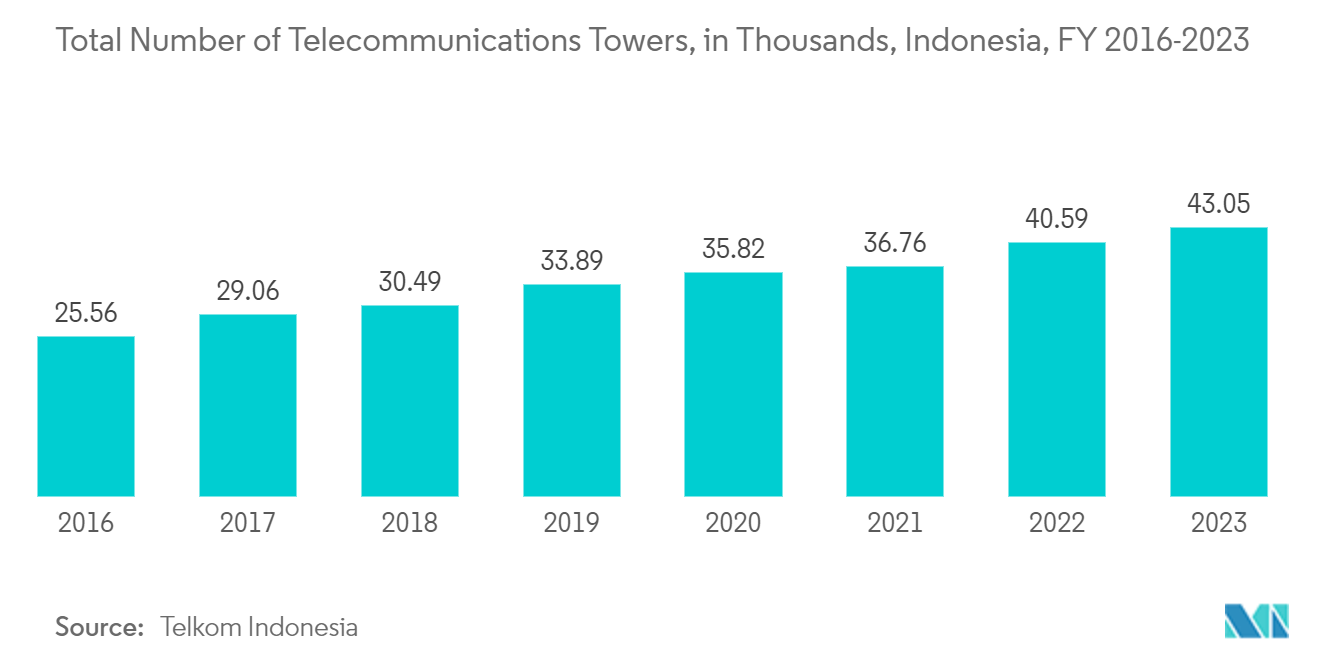
Defense and Government Segment Experiencing Major Growth
- The defense and government sectors in the Indonesian satellite communication market are witnessing significant growth due to the increasing use of satellite communication in intelligence gathering, military operations, surveillance, and disaster management. According to SIPRI, Indonesia's military spending has reached USD 9.5 billion by 2023.
- National government networks, natural disaster relief management, special operations, and nation-building require easily deployable, dependable, secure, flexible, and affordable communications. Defense satellite services can assist military departments in boosting operational effectiveness and mission success probabilities by offering dependable, secure broadband services that permit global interoperability on land, at sea, and in the air.
- By leveraging Inmarsat's commercial L-band Tactical Satellite (L-TAC), SlingShot can establish a tactical network spanning thousands of kilometres, offering a comprehensive range of tactical and operational network functionalities. SlingShot ensures voice and data capabilities for Command and Control (C2), with encryption options, and supports various mission-critical applications, including artillery fire missions, GPS tracking, and biometric analysis. Compared to traditional TACSAT, SlingShot provides enhanced utility, assured channel availability, and a plug-and-play design that requires virtually no training, marking a significant advancement in tactical communications.
- Overall, the defense and government sectors are analyzed to hold a significant market share in the studied market, largely governed by the growing need for satellite connectivity services in the government and defense sectors coupled with rising collaboration among market vendors to launch innovative satcom services for the government sector for a broad range of applications.
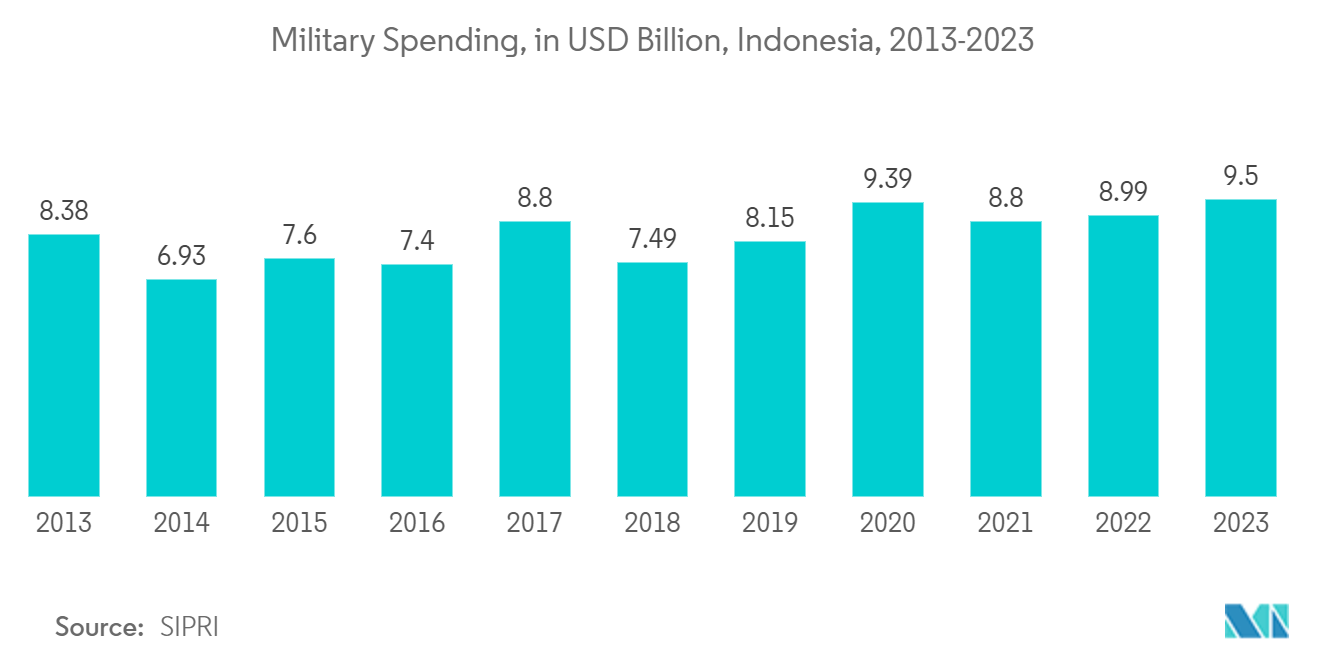
Indonesia Satellite Communications Industry Overview
The Indonesian satellite communications market features a fragmented landscape, with numerous key players such as Ntvsat, Kacific Broadband Satellites Group, PT Pasifik Satelit Nusantara, Starlink, Indosat Ooredoo Hutchison continually enhancing their offerings to outpace competitors. These companies invest heavily in research and development to introduce advanced technologies and improve service quality. Strategic partnerships and mergers are common as firms seek to expand their market presence and customer base.
- July 2024 - PT Pasifik Satelit Nusantara (PSN), Indonesia's first private satellite company, has teamed up with Bengaluru's Elena Geo Tech, a navigation-focused manufacturing firm, to roll out a satellite navigation system in Indonesia. Representatives from both companies formalized the partnership with a memorandum of understanding (MoU) during the India Space event.
- April 2024 - Kacific Broadband Satellites Group and Microsoft have joined forces to deliver high-speed satellite internet to 750 educational and healthcare institutions in rural areas, benefiting 10 million people across the Asia Pacific. Over the next two years, the project will harness the powerful Ka-band beams from the Kacific1 satellite.
Indonesia Satellite Communications Market Leaders
-
NTvsat
-
Kacific Broadband Satellites Group
-
PT Pasifik Satelit Nusantara
-
Starlink
-
Indosat Ooredoo Hutchison
*Disclaimer: Major Players sorted in no particular order
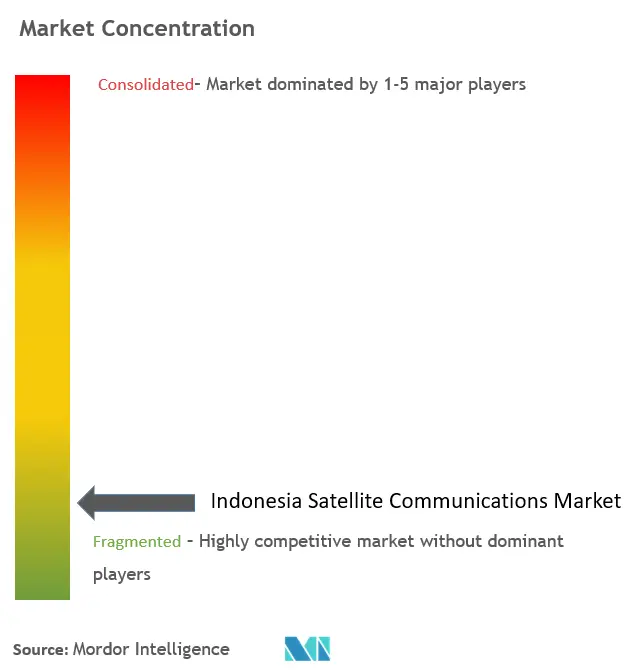
Indonesia Satellite Communications Market News
- April 2024 - The Indonesian Internet Service Providers Association (APJII) inked a memorandum of understanding (MoU) with SpaceX's Starlink. This collaboration seeks to bolster internet accessibility in Indonesia as Starlink, the LEO satellite operator, awaits the green light from regulators to kick off its operations in the country.
- February 2024 - From Cape Canaveral, Florida, SpaceX successfully launched the Merah-Putih-2 telecommunications satellite tailored for Indonesia. Echoing the hues of Indonesia's flag, the Merah-Putih-2 satellite is poised to elevate the country's connectivity. Constructed by Thales Alenia Space on the Spacebus 4000B2 platform, it boasts a robust capacity of no less than 32 gigabits per second. With transponders active on both C-band and Ku-band frequencies, Merah-Putih-2 is primed to extend its coverage across every corner of Indonesia.
Indonesia Satellite Communications Market Report - Table of Contents
1. INTRODUCTION
- 1.1 Study Assumptions and Market Definition
- 1.2 Scope of the Study
2. RESEARCH METHODOLOGY
3. EXECUTIVE SUMMARY
4. MARKET INSIGHTS
- 4.1 Market Overview
- 4.2 Industry Stakeholder Analysis
- 4.3 Impact of Macroeconomic Trends
5. MARKET DYNAMICS
-
5.1 Market Drivers
- 5.1.1 Expansion of 5G Satellite Communication
- 5.1.2 Growth of Low Earth Orbit (LEO) Satellites
-
5.2 Market Challenges
- 5.2.1 Shortfall of Skilled Resource
- 5.3 Technology Trends
- 5.4 Key Use Cases
6. MARKET SEGMENTATION
-
6.1 By Offering
- 6.1.1 Ground Equipment
- 6.1.2 Services
-
6.2 By Platform
- 6.2.1 Portable
- 6.2.2 Land
- 6.2.3 Maritime
- 6.2.4 Airborne
-
6.3 By End-user Vertical
- 6.3.1 Maritime
- 6.3.2 Defense and Government
- 6.3.3 Enterprises
- 6.3.4 Media and Entertainment
- 6.3.5 Other End-user Verticals
7. COMPETITIVE LANDSCAPE
-
7.1 Company Profiles*
- 7.1.1 NTvsat
- 7.1.2 Kacific Broadband Satellites Group
- 7.1.3 PT Pasifik Satelit Nusantara
- 7.1.4 Starlink
- 7.1.5 Indosat Ooredoo Hutchison
- 7.1.6 PT PRIMACOM INTERBUANA
- 7.1.7 PT Telkom Satelit Indonesia
- 7.1.8 Thaicom Public Company Limited
- 7.1.9 SES S.A.
- 7.1.10 PT Telkom Satelit Indonesia
- 7.1.11 PT. Wahana Telekomunikasi Dirgantara
- 7.1.12 PT Pasifik Satelit Nusantara
- 7.1.13 PT. SATELIT NUSANTARA TIGA
8. INVESTMENTS ANALYSIS
9. MARKET OPPORTUNITIES AND FUTURE TRENDS
** Subject To AvailablityIndonesia Satellite Communications Industry Segmentation
The utilization of artificial satellites in telecommunications for connecting different locations on Earth is known as satellite communication. Satellite communications are essential in the worldwide telecommunications network.
Indonesia's satellite communication (SATCOM) market study tracks the overall revenue accrued through the sale of ground equipment along with satellite-based voice and data services by market vendors in Indonesia. Satellite communication is the transfer of data and information via satellites orbiting the Earth; it enables long-distance communication by relaying signals between ground stations and satellite receivers in orbit, enabling television broadcasts, internet access, and phone calls. Moreover, satellite ground equipment comprises a complex array of interconnected systems, components, and infrastructure that work together to support satellite operations, communication, and data processing.
The Indonesia satellite communications market is segmented by offering (ground equipment, services), platform (portable, land, maritime, airborne), end-user vertical (maritime, defense and government, enterprises, media and entertainment, other end-user verticals). The market sizes and forecasts are provided in terms of value in (USD) for all the above segments.
| By Offering | Ground Equipment |
| Services | |
| By Platform | Portable |
| Land | |
| Maritime | |
| Airborne | |
| By End-user Vertical | Maritime |
| Defense and Government | |
| Enterprises | |
| Media and Entertainment | |
| Other End-user Verticals |
Indonesia Satellite Communications Market Research FAQs
How big is the Indonesia Satellite Communications Market?
The Indonesia Satellite Communications Market size is expected to reach USD 341.12 million in 2024 and grow at a CAGR of 15.59% to reach USD 703.97 million by 2029.
What is the current Indonesia Satellite Communications Market size?
In 2024, the Indonesia Satellite Communications Market size is expected to reach USD 341.12 million.
Who are the key players in Indonesia Satellite Communications Market?
NTvsat, Kacific Broadband Satellites Group, PT Pasifik Satelit Nusantara, Starlink and Indosat Ooredoo Hutchison are the major companies operating in the Indonesia Satellite Communications Market.
What years does this Indonesia Satellite Communications Market cover, and what was the market size in 2023?
In 2023, the Indonesia Satellite Communications Market size was estimated at USD 287.94 million. The report covers the Indonesia Satellite Communications Market historical market size for years: 2019, 2020, 2021, 2022 and 2023. The report also forecasts the Indonesia Satellite Communications Market size for years: 2024, 2025, 2026, 2027, 2028 and 2029.
Indonesia Satellite Communications Industry Report
Statistics for the 2024 Indonesia Satellite Communications market share, size and revenue growth rate, created by Mordor Intelligence™ Industry Reports. Indonesia Satellite Communications analysis includes a market forecast outlook for 2024 to 2029 and historical overview. Get a sample of this industry analysis as a free report PDF download.



